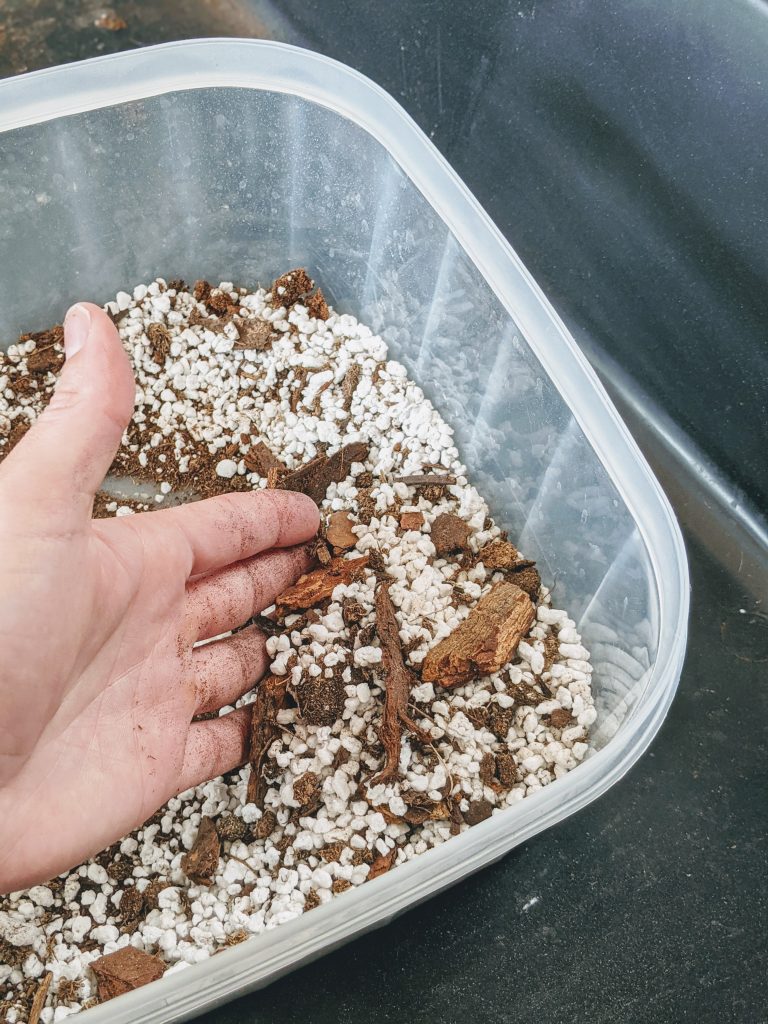A subspecies of the monstera deliciosa, the monstera albo has become one of the hottest plants on the market.
The monstera albo is one of the hottest plants on the market. With its brilliant bright white painted leaves and long, striped stems, it’s no wonder this is a plant on everyone’s most-wanted list.
But before you decide to buy one of these plants for your home (or if you’ve already gotten your hands on one), take time to learn what you need to know about caring for your monstera albo.
We’ll cover all the necessary information including growing conditions, propagation, how to keep the variegation and troubleshooting common problems!
This post contains affiliate links, which means I may make a small commission if you click through and make a purchase.
Monstera Albo Variegation: Important Information

The most important thing you need to know about owning a monstera albo borsigiana (full name), is the type of variegation it has and how it works.
The white stripes and splashes found throughout the leaves are parts of the plant that do not contain the pigment called chlorophyll.
These sections are parts of the plant with mutated cells and do not allow sunlight to be absorbed, only the green parts of the plant. In this case, the green parts of the leaf contain chlorophyll.
The Albo is different from the Thai Constellation which has stable variegation, meaning it will always grow with variegation on all of its leaves.
The Thai’s variegation is more off-white and cream colored compared to the pure white of the Albo.
You can read more about identifying the differences between the monstera albo and thai constellation here.
The monstera albo’s variegation is particularly important to know because it directly affects how much light your plant needs in order to thrive.
Light Requirements
The monstera albo will need bright light. Place this plant in an area that receives indirect or filtered sunlight all day long.
Avoid placing the albo in direct sunlight as this will burn its leaves. The variegated pieces of the leaves are extra susceptible to sunburn.
Without enough light, your plant could eventually start to revert back to green.
This is because if it’s not getting the energy it needs to thrive, it will start to live in the most efficient way it knows how – by producing more green leaves to help absorb more sunlight.
The leaves that are green will also tend to be larger than the leaves with variegated patches.
Watering Requirements
Allow the soil to feel dry about an inch down before giving it a thorough watering.
As delicate as they appear, they’re actually quite hardy plants and will do much better in drier soil conditions than in persistently moist soil.
It’s important to note that over-watering can cause root rot and attract fungus gnats.
Read more about getting rid of fungus gnats here.
Humidity
When caring for monstera albos, remember that they are a tropical rain forest plant. This means they thrive in humid climates with warm temperatures.
Monstera albo will thrive in humidity, don’t always need excessively high amounts.
For most homes, where humidity levels can drop between 20%-65% throughout the year, this plant should do fine.
However, the more humid it is, the happier your albo will be.
Grouping several aroid and humid loving plants together can help, but a plant humidifier is always going to yield the best results.
I like the Levoit humidifier which is compact and sleek, so you’ll never notice it.
Misting the leaves will not provide the type of humidity it requires and can cause more harm than good.
The Correct Soil Mix

Variegated monsteras prefer well-draining soil and should not be left to sit in moist conditions.
A potting mix consisting of peat moss, perlite, coco coir, chunky orchid bark and worm castings is ideal.
This monstera potting mix is ready to go as -s and is easier and cheaper than buying all the substrates separately.
However, I would still recommend adding in extra perlite to get the drainage consistency you need.
Fertilizing Requirements
Because the monstera albo is essentially working overtime to photosynthesize, a fertilizing schedule is important to stick to.
It will need all the extra help it can get. However, over-fertilizing can cause significant damage, so less is more.
In the growing season, use fertilizer every 6 to 8 weeks and even less in the winter.
Try out this specifically formulated monstera plant food.
Keep the Leaves Clean

Another beneficial way to care for your monstera albo is to keep the leaves free of dust.
Since they’re so large they can collect dust easily which inhibits their full ability to absorb sunlight.
I like to wipe the leaves down with a damp cloth at least once per month.
Some people even feel comfortable putting their monsteras in the shower and rinsing them off.
Monstera Albo Propagation

Propagating monstera albo in water
Propagating a monstera in water is straightforward.
Find the node, cut two inches below it and throw it in water. Wait several weeks for roots to develop.
You’ll have to change the water out and monitor for signs of bacteria or rot.
You can read full guide to the easiest way to propagate monsteras here.
Propagating monstera albo in moss
Many people prefer propagating their monstera albos in moss. This is an ideal way to ensure your plant keeps the stunning variegated leaves.
Follow the same method as water, except you keep your cuttings in a vase full of sphagnum moss instead of water.
This sphagnum moss from New Zealand is the highest quality moss I’ve found to date.
Air Layering Propagation
Find the small brown bump (node), make an incision just below it and wrap it in damp sphagnum moss. Then seal it with plastic wrap and allow the node to develop into a larger aerial root.
You’ll have to open up the plastic wrap and mist the moss every few days as it needs to stay moist.
After a few weeks, there should be some healthy roots and you can cut it off and plant in soil.
How to Care for a Monstera Albo Cutting

Whether you’ve just received a plant cutting (so exciting) or want to propagate your mature monstera, you can either leave them in water or sphagnum moss.
A lot of people are afraid of rotting roots if left in water, but I’ve never encountered any problems. You do need to change the water out every few days (for fresh oxygen to the roots) as well as rinse off the roots each time you switch the water.
An easier method is to let the roots sit in damp sphagnum moss.
Some people find this to be easier because you just need to fill up the vessel each time the moss dries out. With the moss being there, it provides more of a reminder when to add water.
Whichever method you choose, it’s important to keep the cutting warm. Avoid window sills or anywhere drafty.
And when you replace the water, make sure it’s at least room temperature or slightly warmer.
Repotting & How to Plant Cuttings
Monsteras do like to be rootbound, so the only time you should repot is when you can see several roots growing out of the drainage holes in the bottom.
Your new pot should only be a couple inches deeper and wider than the current root ball.
Too big, and this could hold too much moisture in the substrate.
How Do You Keep the Variegation in your Monstera Albo?

This is one of the most important things to know about caring for your monstera albo. To keep the variegation and prevent it from reverting to full green, you’ll have to stay on top of pruning.
This means that you need to prune off stems with leaves that are completely green.
The problem with not pruning is that eventually all the leaves will revert to green. You need to almost force or encourage the plant to continue sprouting its beautiful white leaves.
However, you don’t want your entire plant to be white otherwise it won’t be able to photosynthesize.
Strive for a nice balance of white and green on your plant.
Ensuring it gets plenty of bright, filtered light is also a must.
If it’s placed in a corner of your home with low light, it won’t be able to keep its variegation no matter how much you prune it back.
Why are Variegated Monsteras so Expensive?
Monsteras are on the pricey side for a few different reasons.
One, is simply because they’re hard to find. The variegation in the Albo is naturally occurring and cannot be produced in a lab.
Therefore, the only way more albos become available is by cuttings.
Another reason is because they’re rare and everyone wants one right now!
They’ve blown up in popularity over the last couple of years, so with high demand and low supply, the price goes up.
Problems with Monstera Albo and How to Fix Them
Brown tips or edges of the Leaves

Leaves with brown tips or browning along the edges are usually because it’s not getting enough water or humidity.
Make sure you’re watering as soon as the soil is dry about an inch down (or one knuckle deep). This will generally be anywhere from 7 to 12 days.
Brown tips could also develop if it’s too close to a drafty spot in your home, so make sure it’s well protected from vents.
Provide a boost of humidity with a plant humidifier – I like the Levoit humidifier.
Brown Leaves (including new leaves that start brown)
Brown leaves are actually leaf rot which is caused by stagnant air.
If you have a humid spot without air movement, this is usually what can happen.
If you notice leaves that are brown before they unfurl, move the plant to a spot where it can breathe.
Yellow Leaves
Yellowing leaves on a monstera albo is a sign that the plant has been overwatered for too long and is showing signs of root rot.
To fix this, you will have to pull the plant out of its pot and remove as much dirt as possible from the root ball.
Inspect the roots and cut off any that are yellow, brown, black or mushy. Allow it to dry on a paper towel for a few days and then repot with new soil.
Stay Green!
Need more Monsteras in your life? Check out the Adansonii (and it’s different varieties)
Save a pin below to your pinterest boards!


Thank you for unselfishly sharing your knowledge. I have one albo and now I know what I did wrong.
Glad you found it helpful!
Best detailed care I have read to date. Kudos! Love from Singapore!